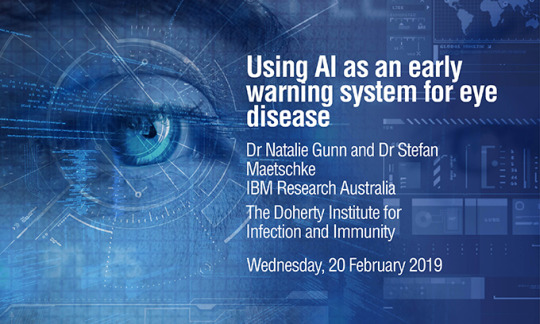
- This event has passed.
Using Artificial Intelligence as an Early Warning System for Eye Disease
20 February 2019 @ 6:00 pm – 7:15 pm

Dr Natalie Gunn and Dr Stefan Maetschke
IBM Research Australia
Loss of vision has a profound impact on a person’s life: financially, economically and socially. The incidence of eye disease is increasing with a global ageing population.
It is estimated that vision loss costs the Australian economy $16B a year, and that does not include the indirect personal and social costs when an individual loses some or all visual capacity. Like many life-changing chronic conditions, early detection is crucial to prevent debilitating vision loss.
IBM Research Australia is developing Artificial Intelligence (AI) solutions to identify early signs of common eye diseases like Glaucoma and Diabetic Retinopathy. In this talk, we will shed light on the current capabilities of our technologies, and share our perspective on how these technologies can help make a difference to the prevention and identification of eye disease, and keep us all active for longer!
Featuring:
 Dr Natalie Gunn is the Healthcare Lead at IBM Research Australia. She joined IBM Research Australia in 2012. The lab had just started and was made up of a vibrant team of early career researchers and software engineers.
Dr Natalie Gunn is the Healthcare Lead at IBM Research Australia. She joined IBM Research Australia in 2012. The lab had just started and was made up of a vibrant team of early career researchers and software engineers.
Natalie began as a technical researcher tasked with producing raw materials for subsequent analysis on silicon chips at the nanoscale. She was part of a team looking at high-throughput screening of a hugely important drug target group at the single molecule level. Upon conclusion of that project, Natalie took over management of a team of computer scientists and engineers and began to develop an agenda around Artificial Intelligence solutions for Eye Health. Today, she is passionate about developing AI that delivers value for individuals, communities and IBM.
 Dr. Stefan Maetschke is a Senior Research Engineer at IBM Research Australia. He was awarded his PhD in computer science from the University of Queensland in 2007.
Dr. Stefan Maetschke is a Senior Research Engineer at IBM Research Australia. He was awarded his PhD in computer science from the University of Queensland in 2007.
Major stages in his career include, R&D at Siemens, Germany, where he developed kinematic and dynamic robot models to improve trajectorial accuracy, research as a Computational Biologist at the Institute for Molecular Bioscience, Australia with a focus on the inference of biological networks, educational work as a Associate lecturer and Course coordinator for software engineering courses at the School of Information Technology and Electrical Engineering, Australia, and software development at Google, USA, where he implemented infrastructure and deep-learning methods for privacy protection of Street View imagery. His current research is focused on the development of machine learning methods to support the diagnosis of eye diseases.
